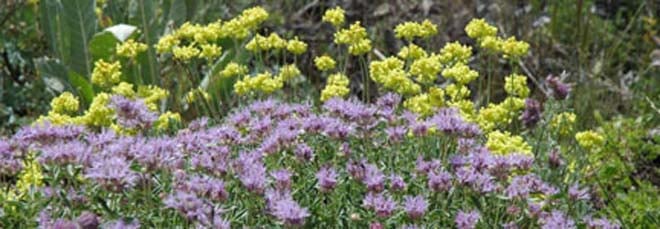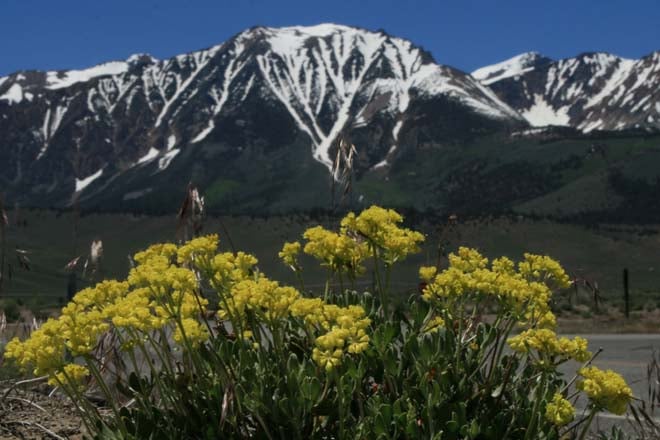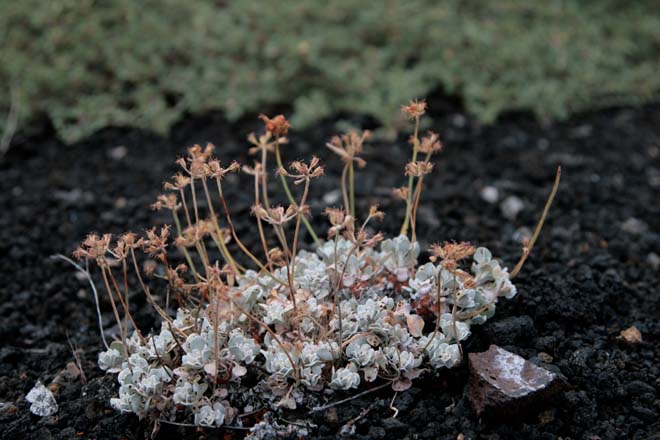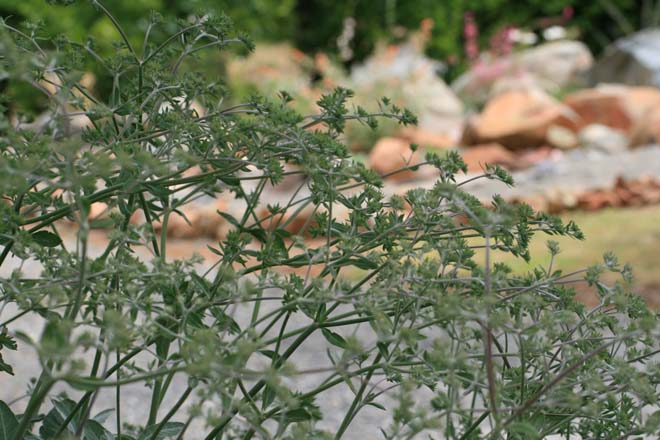
Beneficial Buckwheats

Contributor

This winter, my garden in the north central Sacramento Valley reached a low temperature of 21°F. My big blue oaks were leafless; the frosty nights, grey wet storm patterns, and long nights settled in for the season. In summer, I can count on not having a drop of natural precipitation for four to six monthsand temperatures will top 110°F on a regular basis.
As an avid gardener, I want a lovely, lively garden, but I don’t want to pretend I live in another place with a different climate. So I must be resourceful and expand my knowledge of good garden plants. Judiciously chosen native and climate-appropriate plants can and do make all the difference. For dramatic color and the durability to thrive in my garden, the wild native buckwheats are among my favorites.

Wild buckwheats are eye-catching, sometimes acid yellow, fuchsia pink, or creamy white, low-lying clouds of bloom that you might see on drives, hikes, and in gardens from June through October across the American West. Tenacious native dryland plants, buckwheats thrive in exposed locations on slim soils. They dot high plains and mountain meadows, desert roadsides and rocky slopes, all the while looking bright and appealing in foliage, flower, or gone to seed.



Among the many benefits of buckwheats, these enthusiastic plants are important food sources for pollinators, especially in the late summer months when other flowering plants have retreated to dormancy in the dry heat. Buckwheats reliably attract a whole symphony of pollinators including native bees, wasps, flies, butterflies, beetles, and birds.
Besides being a pleasure to meet on the trail, with good sun and not too much water many buckwheats adapt easily to large or small garden settings.

Botany
Botanists seem to have as strong an affinity for eriogonum as gardeners and native plant enthusiasts. The genus offers rich diversity, complex botanical characteristics and a history of “rapid evolution in arid regions of western North America,” according to Dr. James Reveal, an international eriogonum expert.
Dr. Reveal writes that, “As a native North American genus, Eriogonum is second only to Penstemon. Ecologically, species of Eriogonum occur from the seashore to the highest mountains in the United States. They are among the last plants seen atop the Sierra Nevada and on the ‘outskirts’ of Badwater in Death Valley. The United States Department of the Interior currently
lists some as endangered or threatened species. Some species tend to be weedy, and some of the annual species are aggressively so.”

The genus Eriogonum belongs to the so-called “knotweed” family, Polygonaceae. Edible buckwheat (Fagopyrum esculentum) is an important food crop in the same family. While species of eriogonum do occur elsewhere, the genus is strongly associated with the West. The Jepson Manual: Higher Plants of California says that around 250 species occur in California.
With weediness of some species in mind, home gardeners are advised to be careful when choosing eriogonums in order to avoid accidentally releasing a weed into surrounding wildlands or corrupting the genetics of native eriogonum populations in your area.
The Eriogonum Society
In 2008, two Colorado-based home gardeners and eriogonum enthusiasts, Hugh MacMillan and Bob McFarlane, formed the Eriogonum Society. The group’s objectives are:
1. Enjoying and promoting the use of these plants in the garden,
2. Enjoying and evaluating eriogonums in the wild,
3. Assembling, developing, and sharing information on the propagation, cultivation, identification, and distribution of the eriogonum species,
4. Providing a seed exchange to distribute eriogonum seed for use in gardens,
5. Protecting rare and endangered species of eriogonums, and
6. Advancing the overall understanding of eriogonum from a scientific perspective.
The group will host its third annual meeting and conference weekend in Farmington, New Mexico, in September 2013. Attendees can expect expert presentations on eriogonum, field trips to see plants in the wild, and seed and plant exchanges. The seed exchange (open to society members only) is the best source for good garden selections, because so few species or varieties are available in the nursery trade.


Care and Cultivation
Hugh MacMillan lives near Sedalia, Colorado, at elevation 6,350 feet. Bob McFarlane lives at elevation 5,400 feet in a Denver suburb. MacMillan says he almost never feeds eriogonum, does not prune them, and waters his plants approximately three to five times in summer. McFarlane feeds his with a small dose of all-purpose fertilizer in spring, waters his along with the rest of his garden once a week, and cuts his back as needed for shape.
As illustrated by their native habitats, eriogonums are at their best in lean, well-draining soil and full sun. Dryland plant experts often recommend mulching buckwheats with gravel or mixing gravel in the top few inches of soil around their crowns. They resent being overwatered, especially around their crowns.
Northern California plantsman and garden designer, John Whittlesey, of Canyon Creek Nursery and Design in Oroville, California, recommends pairing buckwheats with “plants they might be found with in the wild, or those that will enjoy similar conditions: coyote mint (Monardella spp.), penstemon, lupine, nepeta, achillea, teucrium, dwarf English lavenders, asters, and native bunch grasses.”
[sidebar]Further resources
The Eriogonum Society www.eriogonum.org
Floral Native Nursery, Chico, California, www.floralnativenursery.com
Las Pilitas Nursery, Escondido and Santa Margarita, California, www.laspilitas.com
Rebecca Lance, Granite Gardens Rare Plants, Sonora, California
Sunscapes Rare Plant Nursery, Pueblo, Colorado, www.sunscapes.net[/sidebar]
Good species of eriogonum for gardens include mid-size and striking yellow Eriogonum umbellatum var. dumosum ‘Shasta Sulphur’; strongly vertical with needle-like foliage and creamy white-blossoms E. fasciculatum (California buckwheat); E. giganteum (St. Catherine’s Lace), which is a large (up to six feet by six feet) specimen with silver-white foliage and much broader, white flower heads; and E. grande var. rubescens, a low variety with silvery foliage and warm pink flowers.
Share:
Social Media
Garden Futurist Podcast
Most Popular
Videos
Topics
Related Posts

Low Maintenance Gardens – Better for Pollinators and People
Autumn 2022 “I come out every day. It’s therapy, my meditation.” Janet’s young garden transformed from overgrown, invasive plants to mostly natives. The dailiness of

Calochortophilia: A Californian’s Love Affair with a Genus
Summer 2022 I can chart the progression of my life by Calochortus. For the last two decades, at least. As a teenage girl growing up

Pacific Plant People: Carol Bornstein
Spring 2022 Public gardens play a key role in demonstrating naturalistic planting design, selecting native and adapted plants for habitat, and testing techniques for reducing

Add Year-Round Interest and Winter Blooms for Pollinators
Spring 2022 This article was created from an Interview by Merrill Jensen with Neil Bell in the Summer of 2021 for our Pacific Plant People











Responses